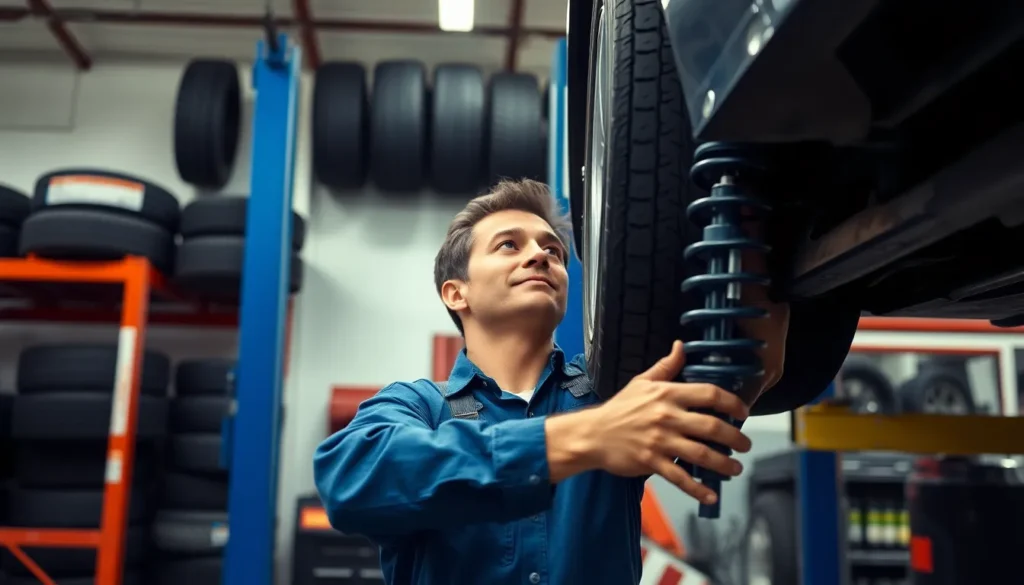Table of Contents
ToggleEver felt like your car’s steering wheel has a mind of its own? If it’s pulling to one side or making you feel like you’re wrestling a greased pig on the road, it might be time to talk alignment. Keeping your wheels in check isn’t just about avoiding a workout every time you drive; it’s crucial for your safety and your wallet.
So how often should a savvy driver like yourself get an alignment? While there’s no one-size-fits-all answer, understanding the signs and knowing when to check in can save you from unexpected surprises. Buckle up, because we’re about to steer you through the ins and outs of wheel alignment, ensuring your ride stays smooth and your tires last longer.
Understanding Wheel Alignment
Wheel alignment involves adjusting the angles of a vehicle’s wheels to ensure they are in line with each other and the road. Proper alignment contributes to better handling and tire longevity.
What Is Wheel Alignment?
Wheel alignment refers to the adjustment of a vehicle’s suspension components. These adjustments ensure that wheels are set to the manufacturer’s specified angles, affecting how the vehicle behaves during driving. Drivers may notice changes in steering response, tire wear, and overall ride comfort when alignment is correct.
Importance of Regular Alignment
Regular wheel alignment is crucial for maintaining optimal vehicle performance. Misalignment often leads to uneven tire wear, which can increase replacement costs. Steering stability and handling improve with proper alignment, enhancing safety during driving. As a rule, checking alignment every 6,000 to 10,000 miles ensures the vehicle operates efficiently. Frequent inspections become essential when hitting potholes or curbs, as these events can easily disrupt wheel alignment.
Factors That Affect Alignment Frequency

Multiple factors influence how often wheel alignment is necessary. Understanding these factors helps maintain optimal vehicle performance.
Driving Conditions
Driving conditions significantly affect alignment frequency. Rough roads, potholes, and gravel can lead to misalignment. Frequent commuting in urban areas with heavy traffic can also contribute to wheel misalignment. Drivers who encounter challenging terrains should consider checking alignment more often. Seasonal changes, especially winter conditions with ice and snow, create additional challenges for alignment. It’s important to inspect a vehicle’s alignment after transitioning from smooth highways to rougher backroads.
Vehicle Type
Vehicle type plays a crucial role in determining alignment frequency. Larger vehicles, such as trucks and SUVs, might require alignment checks more often due to their weight and suspension design. Compact cars, with lighter frames, may maintain alignment longer under normal driving conditions. Specialty vehicles, including sports cars or those with modified suspensions, may also need alignment checks sooner. Regularly checking alignment helps ensure that handling and performance remain at their best.
Tire Wear Patterns
Tire wear patterns provide insight into alignment needs. Uneven tire wear, such as excessive wear on the outer or inner edges, often indicates misalignment. Drivers should inspect tires for unusual patterns regularly. If tires show signs of wearing faster on one side, it’s time for an alignment check. Additionally, new tires should always undergo alignment adjustments to achieve proper wear and longevity. Monitoring tire wear patterns can help catch alignment issues before they lead to costly replacements.
Recommended Alignment Frequency
Maintaining consistent wheel alignment is crucial for vehicle performance and safety. Several factors dictate how often alignment checks should occur.
General Guidelines
Most experts recommend checking wheel alignment every 6,000 to 10,000 miles. Scheduling this maintenance aligns with routine tire rotations. Drivers should also consider having an alignment inspection after hitting potholes or curbs. Regular assessments can prevent uneven tire wear and enhance overall handling. Lastly, different driving environments may necessitate more frequent checks.
Signs You Need an Alignment
Uneven tire wear often signals the need for alignment. If tires show significant wear on one side, misalignment is likely. Steering wheel vibrations can also indicate an issue. Another sign includes a crooked steering wheel when driving straight. Drivers should monitor their vehicle’s tracking; if it pulls to one side, immediate checks are warranted. These signs are crucial in determining alignment needs and ensuring a safer driving experience.
Benefits of Regular Alignments
Regular wheel alignments significantly enhance vehicle performance. Proper alignment minimizes uneven tire wear, prolonging tire life and reducing replacement costs.
Improved Tire Life
Tires benefit from consistent alignment adjustments. Even weight distribution across all tires leads to optimal performance and longer-lasting tread. According to industry data, drivers can extend tire life by 25% with proper alignments. Monitoring tire wear patterns can indicate alignment issues. Uneven wear means it is vital to check alignment. Regular inspections help identify and address alignment problems before they escalate.
Enhanced Vehicle Handling
Vehicle handling improves with correct wheel alignment. Adjusting angles ensures responsive steering and stability, enhancing confidence while driving. Drivers often notice smoother rides when alignment is precise. Improved alignment contributes to better traction, especially on wet or uneven surfaces. It’s crucial to address misalignment signs such as steering wheel vibrations or pulling to one side. Addressing these symptoms leads to a safer and more enjoyable driving experience.
Regular wheel alignment is essential for maintaining a safe and efficient driving experience. By adhering to the recommended check frequency of every 6,000 to 10,000 miles and staying vigilant for signs of misalignment, drivers can prevent costly repairs and ensure optimal vehicle performance. Factors such as driving conditions and vehicle type can influence alignment needs, making it crucial to adjust checks accordingly. Prioritizing wheel alignment not only prolongs tire life but also enhances handling and comfort on the road. Staying proactive about alignment checks can lead to a smoother ride and a safer journey.




